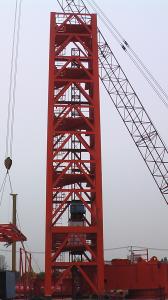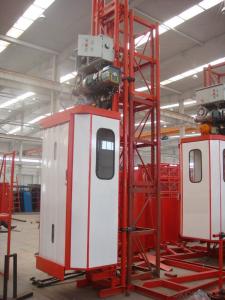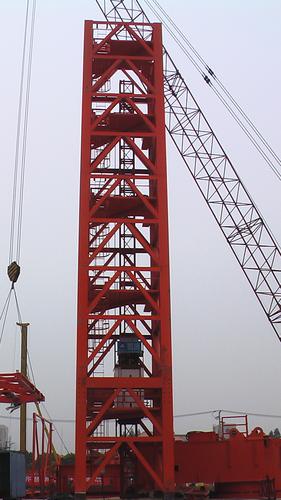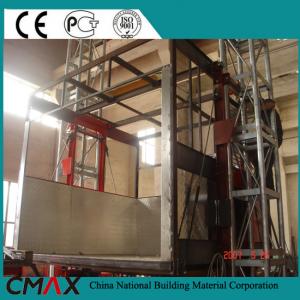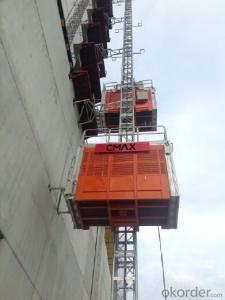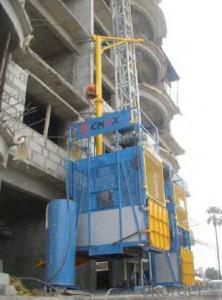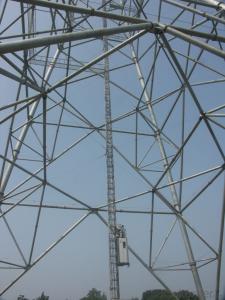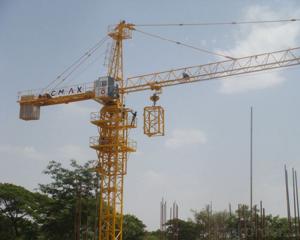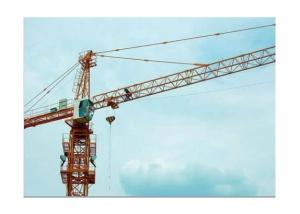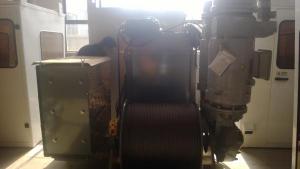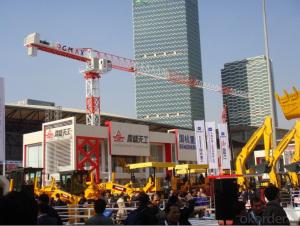Mini Building Hoist for Tower Crane
- Loading Port:
- Tianjin
- Payment Terms:
- TT or LC
- Min Order Qty:
- -
- Supply Capability:
- 40 units unit/month
OKorder Service Pledge
OKorder Financial Service
You Might Also Like
Main Parts of Building Hoist
1. Adopts the most advanced VF speed control device and microcomputer programmable logic controller.
2. Stepless speed control helps eliminate the concussion during start up and braking, steady the operation process, and ensures automated leveling.
3. Adopts open loop V/Fcontrol; the speed control precision can reach ±2~3%. Realizes accurate low speed positioning of the hoist and avoid slipping during downward stopping of hoist.
4. The VF system has current-restriction function, ensuring a small current when motor start up and reducing the concussion to power supply. It reduces the engery consumption and mitigates effects to on site electric equipments.
5. The steadiness during running mitigates concussion to mechanical parts, reduces wears of rack, pinion and the brake and prolongs the spare parts'life.
6. The VF system also has the over voltage protection,low voltage protection, overcurrent, overload and anti-stalling protection functions,
7. The system applies the special software for hoists developed by our company, making the operation more safe and reliable.
SC200TD, SC200/200TD Building Hoist:
1). Cage load capacity: 2, 000kg
2). Lifting speed: 36m/min, 0 - 63m/min, 0 - 96m/min
3). Mast section: Painted or hot dipped zinc
4). Cage: Single cage or twin cage
5). Recommended cage inner dimensions (L x W x H): 2.5 x1.3 x 2.5m, 3.0 x 1.3 x 2.5m, 3.2 x 1.5 x 2.5m, 3.6 x 1.5 x 2.5m, 3.8 x 1.5 x 2.5m, 4.0 x 1.5 x 2.5m, 4.2 x 1.5 x 2.5m, according to requirements of customers
6). Motor and reducing device: Made in China, or uses SEW according to requirements
7). Counterweight: With counterweight or without counterweight
8). Color of cage: Yellow, red, blue
9). Cage load capacity: 1, 200kg, 2, 000kg, 2, 700kg or 3, 200kg
We offer most kinds for building hoist, if you are interested, please feel free to contact me.&
Construction lift with Interver:
Characteristics | Model | Rated Loading | Lifting Speed | Motor Power | |
| | SC200/200D | 2 × 2000kg | 0-36m/min | 2 × (3 × 11kw) 2 × (2 × 13kw) |
SC100/100D | 2 × 1000kg | 0-36m/min | 2 × (2 × 11kw) | ||
| SC200/200Z | 2 × 2000kg | 0-60m/min | 2 × (3 × 15kw) | |
SC100/100Z | 2 × 1000kg | 0-60m/min | 2 × (2 × 15kw) | ||
| | SC200D | 2000kg | 0-36m/min | 3 × 11kw |
SC100D | 1000kg | 0-36m/min | 2 × 11kw | ||
| SC200Z | 2000kg | 0-60m/min | 3× 15kw | |
SC100Z | 1000kg | 0-60m/min | 2 × 15kw | ||
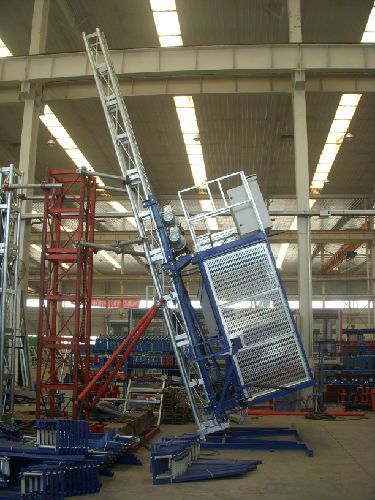
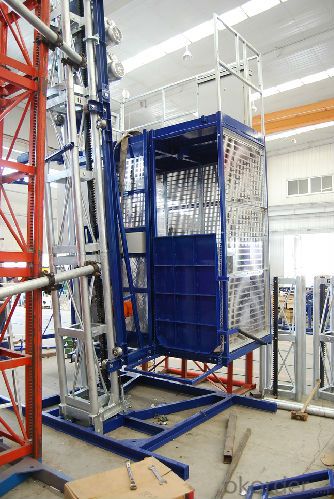
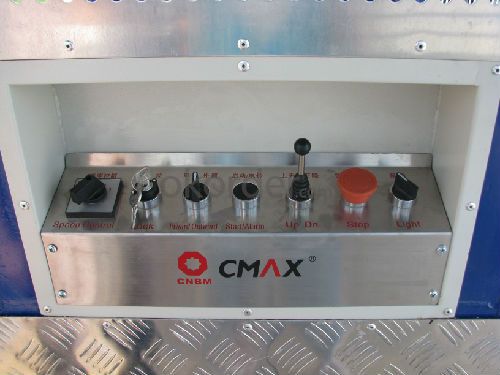
- Q: The construction elevator is commonly used in the process of the project
- Basically: completed from the main body - - complete completion
- Q: The construction elevator always jumps
- Possible causes include: 1, the area that has broken skin in the line, leak the electric trip. There's something wrong with the switch Loose contact points in the line, and bad contact may also jump. It is best to do a thorough examination before closing the lock, and the forced closing is dangerous
- Q: A building hoist is a mechanical device used in construction to lift materials and sometimes workers vertically. It is essential for the efficient movement of materials in high-rise construction.
- <p>The function of a building hoist is to facilitate the vertical transportation of materials, equipment, and sometimes workers within a construction site. It is particularly useful in high-rise buildings where manual lifting would be inefficient and unsafe. A building hoist allows for the rapid and safe movement of materials, reducing labor costs and improving construction speed.</p>
- Q: This question asks for measures to protect lifting equipment from damage during its operation.
- <p>To prevent damage to lifting equipment during operation, ensure regular maintenance and inspection are conducted to check for wear and tear. Adhere to the equipment's load limits and never exceed them. Use appropriate lifting techniques and ensure the load is balanced. Keep the equipment clean and free from debris. Train operators thoroughly on safe operating procedures. Avoid sudden starts or stops, and ensure all safety features and guards are in place and functioning correctly. Regularly check cables, hooks, and other critical components for any signs of damage. Always follow the manufacturer's guidelines and industry safety standards.</p>
- Q: Is it possible to utilize a single-rope lift as an alternative to a building hoist for the purpose of lifting materials or individuals?
- <p>While theoretically possible to use a single-rope lift for lifting materials or people, it is not advisable or practical for construction purposes. Building hoists are specifically designed for construction sites, offering safety features, load-bearing capacities, and stability that single-rope lifts typically lack. Single-rope lifts are more suited for simple, controlled environments and are not equipped to handle the heavy loads, frequent use, or varied conditions of a construction site. The use of a building hoist is recommended for safety, efficiency, and compliance with construction regulations.</p>
- Q: Is it possible to use a building hoist to lift various materials simultaneously?
- <p>Yes, a building hoist can be used for lifting multiple materials at once, provided the total weight does not exceed the hoist's load capacity. It's crucial to ensure that the materials are securely fastened and balanced to prevent tipping or damage. Always follow the manufacturer's guidelines and safety regulations to avoid accidents and ensure the safe operation of the hoist.</p>
- Q: What are the primary materials that are commonly utilized in the construction of hoists?
- <p>Hoists are typically constructed using a combination of metals and synthetic materials for strength and durability. Steel, particularly alloy steel, is a common choice due to its high tensile strength and resistance to wear. Aluminum is also used for its lightweight properties, especially in mobile hoists. Synthetic materials such as nylon or polyester are used for hoist ropes and cables due to their resistance to abrasion and corrosion. Additionally, hoists may incorporate components made from brass, bronze, or other metals for specific parts that require low friction or high resistance to corrosion.</p>
- Q: Explain the key differences between electric and pneumatic lifting equipment in a few sentences.
- <p>Electric lifting equipment is powered by electricity and offers precise control, high efficiency, and is suitable for heavy-duty applications. Pneumatic lifting equipment, on the other hand, is powered by compressed air and is known for its simplicity, safety, and lower cost. It is often used in environments where electrical equipment might be hazardous, such as in the presence of flammable gases or dust. Electric systems can handle heavier loads and provide more precise control, while pneumatic systems are more resistant to overload and offer a fail-safe mechanism in case of air pressure loss.</p>
- Q: This question asks if it is permissible to use a building hoist for the purpose of lifting people.
- <p>No, a building hoist should not be used for lifting people. Building hoists are designed for the transportation of materials and equipment during construction, not for carrying personnel. Using a building hoist to lift people is dangerous and against safety regulations. It poses significant risks, including falls and equipment malfunctions, which can lead to serious injuries or fatalities. Always use designated personnel lifts or other safe methods for moving people in construction settings.</p>
- Q: Is it possible to utilize a building hoist for the transportation of heavy objects?
- <p>Yes, a building hoist is specifically designed to move heavy objects within a construction site or in similar environments. It is a type of crane that can lift and lower materials vertically, making it ideal for transporting heavy items such as construction materials, machinery, and equipment. Building hoists are engineered to handle significant weight loads and are an essential tool for efficient material movement in vertical construction projects.</p>
Send your message to us
Mini Building Hoist for Tower Crane
- Loading Port:
- Tianjin
- Payment Terms:
- TT or LC
- Min Order Qty:
- -
- Supply Capability:
- 40 units unit/month
OKorder Service Pledge
OKorder Financial Service
Similar products
Hot products
Hot Searches
Related keywords
